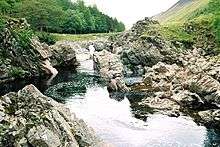Glen Tilt

Glen Tilt (Scottish Gaelic: Gleann Teilt) is a glen in the extreme north of Perthshire, Scotland. Beginning at the confines of Aberdeenshire, it follows a South-westerly direction excepting for the last 4 miles, when it runs due south to Blair Atholl. It is watered throughout by the Tilt, which enters the Garry after a course of 14 miles, and receives on its right the Tarf, which forms some beautiful falls just above the confluence, and on the left the Fender, which has some fine falls also. The attempt of George Murray, 6th Duke of Atholl to close the glen to the public was successfully contested by the Scottish Rights of Way Society. The massive mountain of Beinn a' Ghlò and its three Munros Càrn nan Gabhar (1129 m), Bràigh Coire Chruinn-bhalgain (1070 m) and Càrn Liath (975) dominate the glen's eastern lower half.
Marble of good quality is occasionally quarried in the glen, and the rock formation has long attracted the attention of geologists. One of the earliest was James Hutton, who visited the glen in 1785 and found boulders with granite penetrating metamorphic schists in a way which indicated that the granite had been molten at the time. This showed to him that granite formed from cooling of molten rock, contradicting the ideas of Neptunism of that time that theorised that rocks were formed by precipitation out of water. Hutton concluded that the granite must be younger than the schists.[1][2] This was one of the findings that led him to develop his theory of Plutonism and the concept of an immensely long geologic time scale with "no vestige of a beginning, no prospect of an end."[3] Sir John Clerk of Eldin visited the site and produced geological drawings of the area, immediately upstream of the old Dail-An-Eas Bridge which has since collapsed but the abutments remain as a listed building.[4]
References
- ↑ Robert Macfarlane (13 September 2003). "Glimpses into the abyss of time". The Spectator. Review of Repcheck's The Man Who Found Time.
Hutton possessed an instinctive ability to reverse physical processes - to read landscapes backwards, as it were. Fingering the white quartz which seamed the grey granite boulders in a Scottish glen, for instance, he understood the confrontation that had once occurred between the two types of rock, and he perceived how, under fantastic pressure, the molten quartz had forced its way into the weaknesses in the mother granite.
- ↑ Scottish Geology - Glen Tilt
- ↑ American Museum of Natural History (2000). "James Hutton: The Founder of Modern Geology". Earth: Inside and Out.
- ↑ The Etchings of John Clerk of Eldin: letter from Christopher Dingwall, Perthshire.
External links
- Walking Scotland - Old Bridge of Tilt - Glen Tilt - Gows Bridge
- Pitlochry Walks - GLEN TILT
- Image Bank - Glen Tilt valley sides
- Tour Glen Tilt, Tour Scotland.
 This article incorporates text from a publication now in the public domain: Chisholm, Hugh, ed. (1911). "Glentilt". Encyclopædia Britannica. 12 (11th ed.). Cambridge University Press.
This article incorporates text from a publication now in the public domain: Chisholm, Hugh, ed. (1911). "Glentilt". Encyclopædia Britannica. 12 (11th ed.). Cambridge University Press.
Coordinates: 56°49′59″N 3°46′34″W / 56.833°N 3.776°W